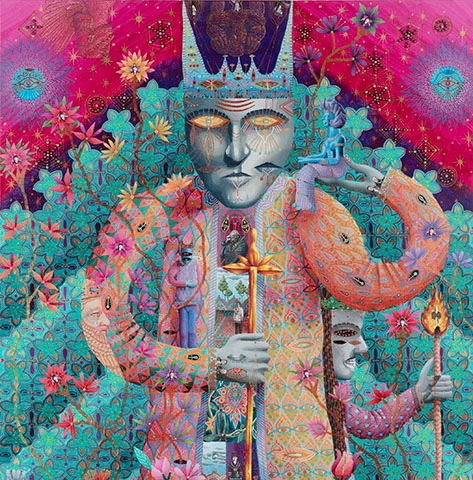LaToya Ruby Frazier (American, born 1982). If Everybody’s Work Is Equally Important? (II), 2017. Four cyanotypes, each image and sheet 28 x 22 in. Published by the Lower East Side Printshop, New York. Purchase, William G. Roehrick '34 Art Acquisition and Preservation Fund (2017.4a-d)

Assyrian. Fragment of a relief, c. 883–859 BCE. Gypsum with remnants of red pigment, 23¼ x 14? x 1½ in. (59.2 x 37 x 3.8 cm). Gift of Henry Dwight Williams, HMA1869 (1868.5)
Art can move us in a variety of ways, emotional and otherwise, but how can it suggest movement? One of the great endeavors in art making is to convey movement within a naturally static medium. “Nothing rests in our compositions,” modernist photographer Ilse Bing once stated, “even if it seemingly rests, there is a dynamic of movement which you feel.” Presented below, for your enjoyment and contemplation, are the top ten poses and gestures that can be seen in our fall exhibition, on view until December 10th.
LaToya Ruby Frazier (American, born 1982). If Everybody’s Work Is Equally Important? (II), 2017. Four cyanotypes, each image and sheet 28 x 22 in. Published by the Lower East Side Printshop, New York. Purchase, William G. Roehrick '34 Art Acquisition and Preservation Fund (2017.4a-d)
1). The movements captured in Frazier’s suite of cyanotypes—choreographed for a performance piece the artist created with artist Liz Magic Laser—are borrowed from mid-century advertisements for the steel industry.
Vanessa German (American, born 1982). i will never smile again, 2016. Mixed-media assemblage, 85¾ x 29 x 24 in. (217.8 x 73.7 x 61 cm). Purchase, William G. Roehrick '34 Art Acquisition and Preservation Fund (2016.15)
2). The hand of German’s sculpture, created as a figure of protection and healing much like nkisi figures made by the Kongo peoples of central Africa, extends toward the viewer in a meaningful gesture of invitation or supplication.

Sebastião Salgado (Brazilian, born 1944). Kuwait, 1991. Gelatin silver print, image 11¾ x 17? in. (29.8 x 44.8 cm), sheet 13? x 19? in. (34.4 x 49.8 cm). Purchase, William G. Roehrick '34 Art Acquisition and Preservation Fund (2015.2)
3). The way Salgado captured the listless poses of two weary oil-covered workers in the Greater Burgan oil field in southeastern Kuwait makes them appear almost statue-like.

Garry Winogrand (American, 1928–1984). New York City, from the portfolio “Women are Beautiful,” 1968 (printed 1981). Gelatin silver print, image 8? x 13¼ in. (22.5 x 33.8 cm), sheet 11 x 14 in. (27.9 x 35.4 cm). Gift of Christopher P. Gane (1982.29.1)
4). I have always loved this image, in which the gestures of two children playing patty-cake are juxtaposed with those of their mothers, backs toward them, endeavoring to hail a cab.
Ilse Bing (American, born Germany, 1899/1900–1998). Figaro Fandango, Glyndebourne, 1937 (printed 1984). Gelatin silver print, image 13? x 10¼ in. (34 x 25.9 cm), sheet 14 x 11 in. (35.6 x 27.8 cm). Gift of Dr. Stephen Nicholas (2015.11.2)
5). Here Bing captures a dancer mid-step making a dramatic pointed gesture in the third act of Mozart’s comic opera Le nozze di Figaro (The Marriage of Figaro), presented at Glyndebourne Festival Opera in East Sussex, England on June 8, 1937.

Oskar Kokoshka (Austrian, 1886–1980). Study for Woman in Blue, c. 1919. Ink on paper, 14½ x 19? in. (37 x 48.6 cm). Bequest of William G. Roehrick, Class of 1934, H1971 (1996.15.41)
6). In this study for a painting, Kokoshka depicts his subject lying on a couch in a classic odalisque pose in the French tradition of Jean-Auguste-Dominique Ingres and others.
Elihu Vedder (American, 1836–1923) and Charles Keck (American, 1875–1951). The Boy, 1902. Bronze, 40? x 21 x 23¼ in. (103.3 x 53.5 x 59.1 cm). Gift of Mr. and Mrs. Philip V. Rogers (1994.104)
7). Vedder found inspiration for the contrapposto pose of this sculpture—once intended to top a fountain—in ancient Roman and Greek sculpture, which he had extensive access to in Italy, where he resided from 1856 until the end of his life.
attributed to Teisai Hokuba (Japanese, 1771–1844). Untitled [First Encounter of Kintaro’s Parents], c. 1830. Ink and mineral pigments on silk, 10? x 11? in. (25.6 x 28.3 cm). Gift of Omar S. Pound, Class of 1951 (1985.47)
8). In this scene drawn from The Adventures of Kintaro, the Golden Boy, the hero’s parents—an aristocratic woman and a humble guard named Kintoki—meet for the first time. The energy of their meeting is apparent is the way the woman dramatically draws back from the man.
Antonio da Trento (Italian, 1508–1550), after Parmigianino (Italian, 1503–1540). Augustus and the Tiburtine Sibyl, c. 1527–30. Chiaroscuro woodcut from two blocks, sheet (trimmed to edges of block) 13¾ x 10½ in. (34.9 x 26.5 cm). Purchase (1992.24)
9). This woodcut depicts a scene from the Legenda aurea (Golden Legend) in which the Tiburtine sibyl—one of a number of female oracles—faces the ancient Roman emperor Augustus and gestures emphatically toward the sky, where the Virgin Mary with the Christ Child have appeared in answer to the emperor’s question as to whether a greater ruler than he would ever exist.
Mesoamerican (Zapotec). Funerary urn, c. 350–600 CE. Terracotta with remnants of pigment, 13½ x 9½ x 6 in. (34.3 x 24.1 x 15.2 cm). Anonymous Gift in Honor of Alessandro Giangola, Class of 1998 (2002.16)
10). This Zapotec urn takes the form of a male figure decked out in a headdress, face mask, pectoral, and garment. The figure is seated cross-legged and the taut position of his shoulders and upper body suggest that he has placed his hands on his knees the moment before. As we contemplate the urn, along with the other works of art in the exhibition, he contemplates us back, returning our gaze















